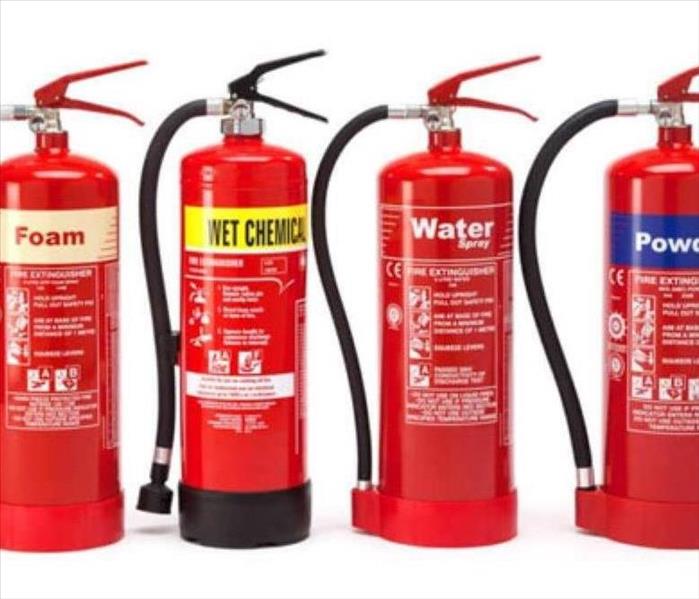Did you know there are six different types of fire extinguishers?
4/15/2021 (Permalink)
As most people would think you would just buy a fire extinguisher and if a fire occurs you’re fine right? Well, what you may not know is there are actually six different types of fire extinguishers and they all don’t work on every fire.
- ABC POWDER FIRE EXTINGUISHER
An ABC powder fire extinguisher has many advantages as it is a multi-purpose extinguisher and is therefore one of the most common extinguishers to have. A powder extinguisher sprays chemical powder comprised mostly of monoammonium phosphate. This acts to cover the fire and suffocate it. A Powder extinguisher works effectively since it is not an electrical conductor and since it can effectively break the chain reaction in a liquid or gas fire, something a water extinguisher cannot do.
- CARBON DIOXIDE FIRE EXTINGUISHER
A carbon dioxide fire extinguisher is one of the most sanitary types of extinguishers to use as it leaves no remnants and requires no cleanup. The CO2 extinguisher extinguishes CO2. Meaning it eliminates oxygen out of the fire, effectively suffocating it of oxygen. It is used on fires that involve flammable liquids and on electrical fires.
- WET CHEMICAL FIRE EXTINGUISHER
The wet chemical extinguisher is a specialized type of extinguisher that the primary use is on fires involving cooking animal and vegetable fats or oils. These extinguishers contain a solution composed of potassium. The liquid mist it sprays cools the fire. Second, due to the chemical reaction of the solution with the cooking fat or oil, a thick soap-like substance forms, sealing the surface of the liquid to prevent it from reigniting. The wet chemical extinguisher is for a kitchen setting. It can also be effective for fires where a material such as wood or paper has caught fire.
- WATER MIST FIRE EXTINGUISHER
This type of extinguisher releases minuscule water molecules that fight the fire on a variety of levels. First, because so much water is dispersed in such a minuscule fog-like form, the level of oxygen in the air is decreased, which in return suffocates the fire. Second, the water molecules are drawn to the fire and, as water always does, acts to cool it. The most unique thing about the water mist extinguishers, is that the water has been demineralized, meaning the minerals have been removed. As a result, it can be used on electrical fires, as the demineralized water does not conduct electricity, as well as on burning liquids/gases that a standard water extinguisher could not be applied to.
- FOAM FIRE EXTINGUISHER
Foam fire extinguishers are suitable for flammable liquids but not effective for gaseous fires. They spray a foam that expands when it hits the air and covers the fire. This prevents the vapors from rising off the liquid to feed the fire, therefore starving it of fuel. Also, because the foam is mixed with water, it has a cooling effect. Foam extinguishers are some of the best for liquid fires, such as gasoline fires, but can also be used on fires involving solid combustibles like wood.
- CLEAN AGENT FIRE EXTINGUISHER
This type of fire extinguisher is stored in its liquid form, when sprayed and hits the air, it converts to its gas form which is nonconducting, safe for use while people are present, leaves no remnants, and has a very short atmospheric lifetime, making it eco-friendly. The gas, is usually made of Halon, extinguishes fire by reducing the oxygen levels and delaying the chain reaction. Because it is nonconducting and so clean, it is ideal for rooms or businesses filled with electrical and computer equipment.




 24/7 Emergency Service
24/7 Emergency Service
